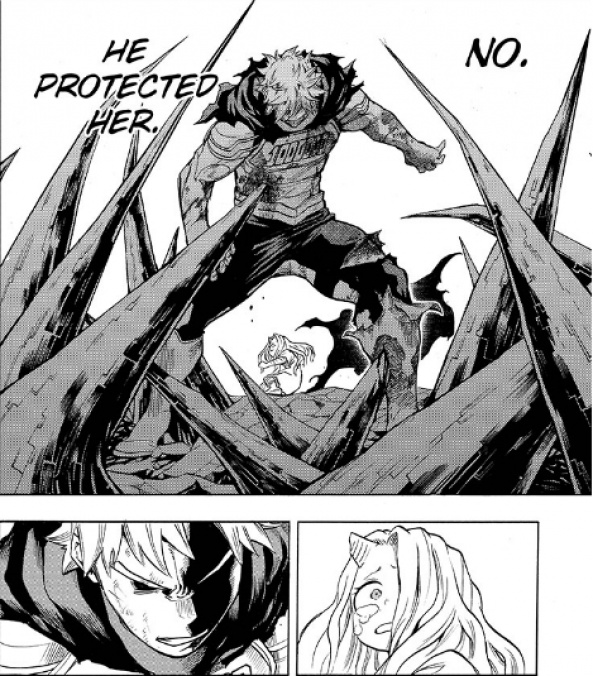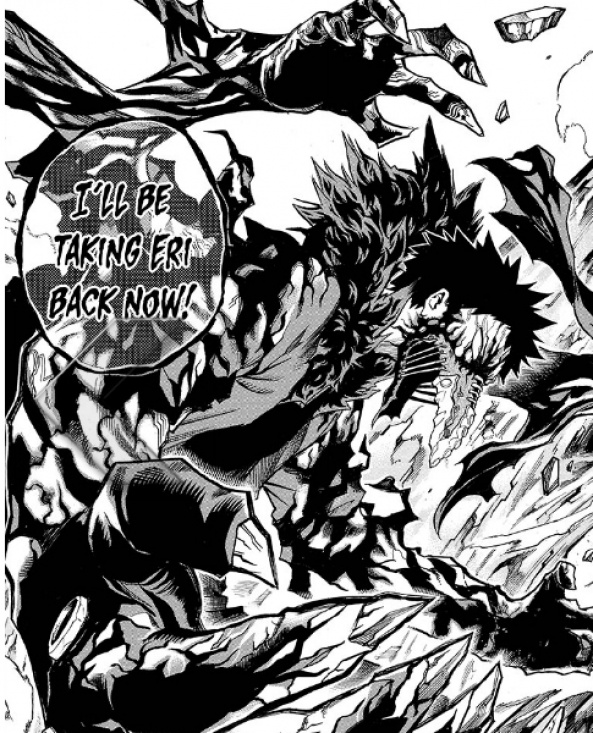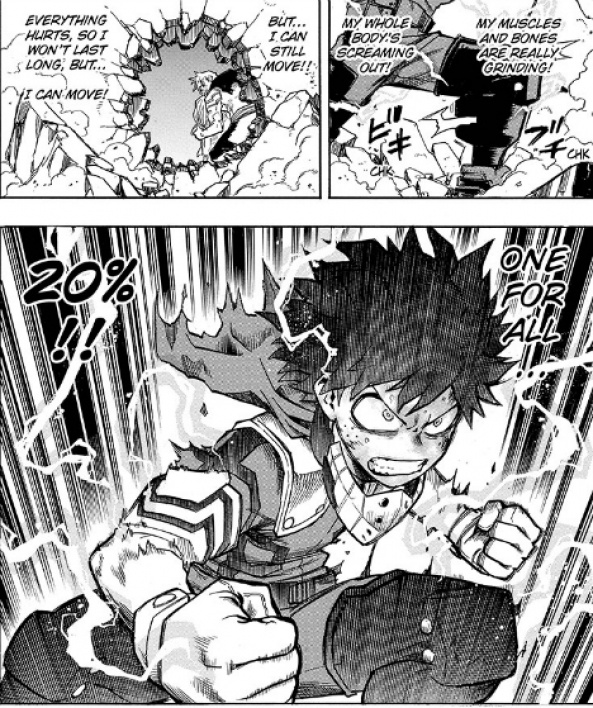Due to another one-week break, brought about by another brief illness for series’ mangaka Kōhei Horikoshi, we have received just three fantastic chapters of “My Hero Academia” over the last month. As I discussed in the previous instalment, of “Go Beyond,” the refocusing of the story toward the exploits of Lemillion and Overhaul indicated that we were entering the closing stages of the current arc. While this month’s chapters have not yet brought the current arc to an end, it has certainly delivered material that is suspenseful, captivating and impactful.
These chapters begin with the end of Lemillion’s involvement – in the fight against Overhaul – before allowing for a heroic entrance from Deku and co., whereafter the newly arrived group takes the lead. As of the end of Chapter 154 (titled, ‘Unforeseen Hope’), we are left with Deku and Overhaul facing each other down. Within these three chapters though, despite the conflict between Overhaul and the heroes continuing to unfold throughout, Horikoshi manages to convey a manic scene where actions are driven by a mix of determination and desperation. This scenario, where anything can happen, helps to heighten the tension and thus enhance the reading experience.

An aspect of this series that I truly appreciate, again handled masterfully by Horikoshi in these three chapters, is the ability to invoke genuine suspense during a period of conflict. Given the number of characters involved, and the effort that has already been made to reach this point in the arc by the protagonists, there is bound to be underlying tension felt by the reader. But Horikoshi manages to go above and beyond in this instance, furthered by his choice dialogue and emotive art rather than relying on cheap stakes and manufactured suspense, as other series might. I believe this was successfully managed by having the actions of the characters involved be purely driven by one of two things: determination with conviction, or pure desperation.
By having each event found in these chapters be rooted in one of these two things, the actions taken are instantly memorable to the reader. The feelings experienced by the characters when carrying out these actions are relatable and easily communicated to the series’ audience, which is primarily enabled by Horikoshi’s talent for portraying detailed facial expressions through his art. The first example that is worth highlighting can be found at the very start of Chapter 152 – titled ‘Lemillion’ – where Overhaul has tossed a case of five quirk-destroying bullets over to Nemoto. While it is interesting to note the specific chapter title, given that it finishes a theme that started with C.150 (ie. the evolution of the civilian Mirio Togata to the hero Lemillion), the fact that Overhaul demonstrates his desperation by relying on another and utilising valuable goods is more important for the topic in hand. The value of these bullets is confirmed by the brief flashback found at the beginning of this same chapter. Overhaul’s willingness to use such a precious commodity on Lemillion, however, is proven conclusively to be an act of desperation following Nighteye’s accusation that Overhaul was actually scared of Lemillion in Chapter 154.

Horikoshi proceeds to maintain the high level of tension in this scene, after this decision by Overhaul, by transitioning from his desperation into an act of determination (bolstered by unwavering conviction) from Nemoto. Rather than panicking, the henchman takes a second to assess the situation and exploit the information he has at his disposable, regarding his target. This thoughtful consideration is spurred on by his insider knowledge of the contents of these particular bullets, which is entirely dependant on his unique position within the Shie Hassaikai’s Eight Bullets, wherein his Confession quirk eliminates the possibility of Overhaul ever lying to him. This flexible dynamic between master and underling allows the desperate wish of the senior figure to be assessed, and then carried out with conviction by his avid supporter, in turn making for a realistic and relatable level of trust between the villains.
The Shie Hassaikai aren’t the only ones in this scenario that Horikoshi scripts gripping decisions for though, alongside the motives behind those same decisions, in the face of adversity. The truly enthralling aspect of this set of encounters is the back and forth between the opposing sides, in regards to the lengths they’re willing to go to emerge successful in their endeavor. This is applicable to Lemillion throughout this chapter, and firstly following Nemoto’s decision to shoot the precious bullet in the direction of the helpless Eri. The intermingling of character drives is apparent here, as Nemoto exploits Lemillion’s motives for acting heroically in this situation in order to gain the upper hand. Having used his quirk earlier he knows that Lemillion is in a position where he would do anything to save the young girl, which thus implies desperation. The realisation of this desperate need to save Eri leaves the previously invincible Lemillion exposed to danger, and given the threat of the villains and the established stakes of the encounter, Horikoshi follows through by having Lemillion lose his quirk in an utterly heart-wrenching manner. This is once again emphasised by Horikoshi’s fantastic panelling, use of shading and emotion-filled character expressions.
Continued below
After this instance there are numerous other examples of determination or desperation driven action, in this month’s batch of chapters. These include: Lemillion fighting on as a hero despite losing his quirk (driven by the debt he feels he owes to Eri for abandoning her once before), Toga and Twice’s determination to make Overhaul pay (for killing Magne and embarrassing the League) and Overhaul’s desperate attempts to activate his quirk following Eraserhead’s arrival (in addition to his subsequent reliance on Chronostasis to incapacitate the troublesome pro). The close proximity of these actions to one another all helps to maximise the narrative potential of this conflict as a whole – typified by the relentless tension and excitement – and yet Horikoshi does not stop there. Alongside this high-octane action and the emotional stakes that accompany it, the mangaka seeks to also explore a variety of sacrifices made by the characters involved in this chaotic clash.
The first set of sacrifices that can be seen in these three chapters, are those that are made out of desperation. Chronologically the first is Lemillion’s two-fold sacrifice – of his quirk and then his body – as the hero strives to do anything and everything to protect the girl he once left behind. This kind of sacrifice is then echoed by Nighteye, the pro hero from whom Lemillion has interned under and learned tremendously as a result, who puts his own body on the line to allow his depowered protégé (and the girl who he himself risked so much to protect) to escape from further harm at the hands of Overhaul. The dangers of professional hero work are displayed fully here, as Nighteye fearlessly faces an enemy he is incapable of defeating despite his impressive powers of prediction, and as such he appears to lose his left arm and is skewered through the chest by one of Overhaul’s manipulated spikes. As I have set out before, this kind of narrative execution that both hints at the dangers of the hero’s job and then realises them in a rather shocking fashion, allows for Horikoshi to continue telling a story that is gripping to its readers because anything is possible and nobody is truly safe.

The same level of unpredictability can also be applied to the villains in this story, given Overhaul’s actions at the end of Chapter 153 (titled ‘Transform!’). This alarming turn of events, that certainly makes the heroes’ situation seem hopeless, is once again a two-fold sacrifice (demonstrating once again Horikoshi’s ability to layer complexities into his writing of this series). The first is that of Nemoto’s life, whose trust Overhaul abuses and whose life Overhaul takes in order to further his own chances of survival and success. By using his underling’s cells to recover his health and replenish his stamina, all the while taking on a more monstrous form that allows for greater use of his own quirk, it is clear that Overhaul considered Nemoto to be nothing more than a tool at his disposal. This is made even clearer by the fact that following the transformation that Overhaul undergoes; the mask that Nemoto was wearing is visible on one of his newly formed arms.
The second aspect of sacrifice seen through this act is the forgoing of Overhaul’s beliefs and boundaries regarding other people, as it would appear that he suffers from mysophobia. This pathological fear of contamination (displayed by his plague doctor-like mask) and germs has been clear since his introduction into the series, and is a key character trait associated with him. And yet it is clear that he is willing to actually combine with another human being (ie. Nemoto), if it helps him to retrieve Eri and emerge victorious. This palpable desperation, demonstrated by the young Yakuza boss, once again helps to maintain a high level of tension and ensures that the nearby heroes are still well under threat.

A final sacrifice I wish to highlight, seen in the last of these three chapters, is that of Deku’s. The reason I wish to do this now, is to draw a vast comparison between the desperation of Overhaul’s transformation and the undoubtedly dogged determination seen in Deku’s own change, but all the while acknowledging that Deku’s is far more restrained. In the past, we have seen Deku resort to using 100% of his power, when backed into a corner. This has normally ended favourably for him, but at the expense of broken bones and becoming debilitated. Yet as Eraserhead informed Deku in one of the first chapters of the series, he can’t expect to save anyone as a hero if he needs saving himself. This point is reiterated once again in the most recent chapter however, when Eraserhead tells Deku to: react accordingly, not go overboard, and most importantly to not incapacitate himself.
Continued belowIt is clear that Deku has changed from earlier in the series, as – although his transformation is not as immediate as the one we see from Overhaul at the end of Chapter 153 – the way in which he progressively deals with crisis is more level-headed. Rather than utilising 100% of One For All this time around, he instead allows 20% of the power to flow throughout his entire body. While this is a huge step up from his previous whole-body power level, Horikoshi tempers expectations by inserting that this level of power exerts a huge toll on Deku’s muscles and bones. Although this form is not a long-term solution by any stretch, it does present him with the ability to briefly clash with Overhaul while avoiding the potentially fatal drawback of incapacitating himself (as he was warned by Eraserhead to avoid). This turn of events demonstrates Deku’s penchant for tactics and outside-the-box thinking that has always been there, whilst showing an evolution in his wider thinking and conduct in pressured situations. While the sacrifice on his body that this change presents may pale in comparison to that of Overhaul’s, the transformation seen within their respective characters is on equal footing, in my opinion.

So reflecting on this batch as a whole, I’m incredibly excited with the way in which Horikoshi has handled this conflict. Each week is tense, yet thrilling, and I can’t wait to see how this all wraps up. Given the sacrifices that we’ve seen characters make in both this set of chapters and the wider arc as a whole though, I’m equally as excited to see the fallout of an arc such as this that has delivered on so many action-oriented and emotion-filled levels. Either way, I hope you’ll all join me next month to discuss the beautifully constructed series of “My Hero Academia.”






